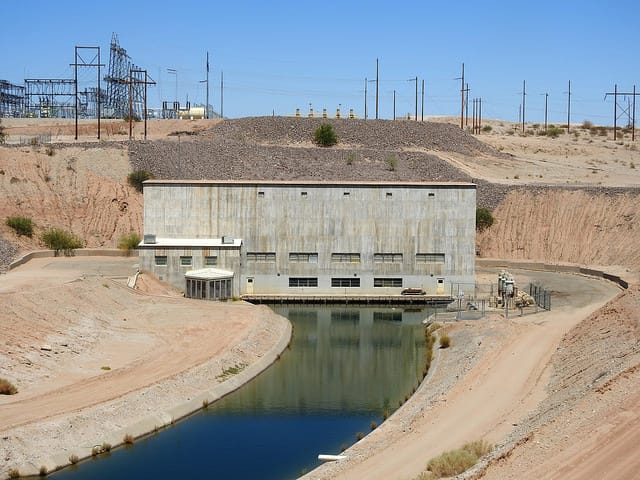Cornucopia’s Take: Officials now suspect the bacterial outbreaks last year occurred because a California irrigation canal carried E. coli from a 100,000 head cattle feedlot to the irrigation ponds used to water romaine lettuce. Officials are draining the canal early this season for repairs, testing, and removal of any E. coli-contaminated sediment. Feedlots promote dangerous bacterial growth because animals stand in very close quarters in their own waste and a high corn diet fosters more virulent E. coli bacteria. Authentic organic livestock operations ensure that cattle remain on grass in smaller herds, a practice that promotes animal health and greatly reduces the risk of outbreaks like these.
Draining canal may reveal answers about romaine contamination
Food Safety News
by Dan Flynn
 |
Drainage District pumping plant Source: Mark Holloway, Flickr |
Arizona’s Wellton-Mohawk Irrigation and Drainage District plans an early drawdown this year of water in a canal suspected of contaminating romaine lettuce that was grown in the Yuma region and linked to a deadly E. coli outbreak in 2018.
After the drawdown, district officials say the canal will be allowed to dry out so crews can remove sediment where E. coli might have colonized. The plan also includes concrete repairs. Colonized E. coli in the sediment is “one theory of many,” according to district General Manager Eiston Grubaugh. But, he said, it’s “something we can try.”
The federal Centers for Disease Control and Prevention said the deadly, 36-state E. coli outbreak linked to romaine grown in the Yuma region was over as of June 28, 2018. Five people among 210 confirmed with infections died. Ninety-six of the outbreak victims required hospitalization.
A U.S. Food and Drug Administration investigation turned up water samples from the eastern Yuma County canal that tested positive for the same genetic type of E. coli that was associated with the outbreak. FDA officials have suggested that a nearby cattle feedlot was the possible source of the contamination. The feedlot has a capacity of more than 100,000 head.
Subsequent testing of the canal water, however, did not turn up the outbreak strain again. Fields of 22 romaine growers in the area also did not turn up anything more definitive. However, the Yuma area fields had already been harvested and plowed under by the time investigators collected soil samples.
With no certain cause, Arizona and California growers made changes based on what they did know. Harvest in the Yuma region is again underway and will continue through mid-March.
Both states employ Leafy Greens Marketing Agreements (LGMAs) that govern food safety practices their members must follow. Changes for the Yuma region growers since the outbreak include:
- Daily cleaning of equipment;
- A more extensive review of crop impact after weather events such as flooding or high winds;
- Mandatory traceability measures; and
- A 1,200-foot minimum buffer zone between growing fields and feedlots with 1,000 or more animals. Previously the buffer requirement was 400 feet.
Additional research into vulnerabilities from infrastructure and industry practices is planned for 2019.
Together California and Arizona produce 90 percent of the leafy greens consumed in the United States. Growers in the two states voluntarily join the LGMAs, which are nonprofit organizations operating under the administration of state agriculture departments.
2018’s second romaine outbreak declared over
Also on Wednesday, the federal Centers for Disease Control and Prevention announced that 2018’s second E. coli O157:H7 outbreak involving romaine is likely now over. The implicated romaine was grown in the Northern and Central California growing region.
The second outbreak ends with 62 confirmed cases in 16 states with 25 requiring hospitalization. Those illnesses began last October with the most recent onset reported as last Dec. 4. There were no deaths.
The California outbreak investigation has centered on Adam Bros. Farming Inc., a growing operation in Santa Barbara County. The outbreak strain of E. coli was found in the sediment of an irrigation pond on the farm. Romaine harvest there was concluded before the pathogen was found, but the farm owners recalled other lettuces and cauliflower in mid-December because of concern that water from the pond had come into contact the produce.

